Huanjing Yue
Distribution-Specific Learning for Joint Salient and Camouflaged Object Detection
Aug 08, 2025Abstract:Salient object detection (SOD) and camouflaged object detection (COD) are two closely related but distinct computer vision tasks. Although both are class-agnostic segmentation tasks that map from RGB space to binary space, the former aims to identify the most salient objects in the image, while the latter focuses on detecting perfectly camouflaged objects that blend into the background in the image. These two tasks exhibit strong contradictory attributes. Previous works have mostly believed that joint learning of these two tasks would confuse the network, reducing its performance on both tasks. However, here we present an opposite perspective: with the correct approach to learning, the network can simultaneously possess the capability to find both salient and camouflaged objects, allowing both tasks to benefit from joint learning. We propose SCJoint, a joint learning scheme for SOD and COD tasks, assuming that the decoding processes of SOD and COD have different distribution characteristics. The key to our method is to learn the respective means and variances of the decoding processes for both tasks by inserting a minimal amount of task-specific learnable parameters within a fully shared network structure, thereby decoupling the contradictory attributes of the two tasks at a minimal cost. Furthermore, we propose a saliency-based sampling strategy (SBSS) to sample the training set of the SOD task to balance the training set sizes of the two tasks. In addition, SBSS improves the training set quality and shortens the training time. Based on the proposed SCJoint and SBSS, we train a powerful generalist network, named JoNet, which has the ability to simultaneously capture both ``salient" and ``camouflaged". Extensive experiments demonstrate the competitive performance and effectiveness of our proposed method. The code is available at https://github.com/linuxsino/JoNet.
FEALLM: Advancing Facial Emotion Analysis in Multimodal Large Language Models with Emotional Synergy and Reasoning
May 19, 2025Abstract:Facial Emotion Analysis (FEA) plays a crucial role in visual affective computing, aiming to infer a person's emotional state based on facial data. Scientifically, facial expressions (FEs) result from the coordinated movement of facial muscles, which can be decomposed into specific action units (AUs) that provide detailed emotional insights. However, traditional methods often struggle with limited interpretability, constrained generalization and reasoning abilities. Recently, Multimodal Large Language Models (MLLMs) have shown exceptional performance in various visual tasks, while they still face significant challenges in FEA due to the lack of specialized datasets and their inability to capture the intricate relationships between FEs and AUs. To address these issues, we introduce a novel FEA Instruction Dataset that provides accurate and aligned FE and AU descriptions and establishes causal reasoning relationships between them, followed by constructing a new benchmark, FEABench. Moreover, we propose FEALLM, a novel MLLM architecture designed to capture more detailed facial information, enhancing its capability in FEA tasks. Our model demonstrates strong performance on FEABench and impressive generalization capability through zero-shot evaluation on various datasets, including RAF-DB, AffectNet, BP4D, and DISFA, showcasing its robustness and effectiveness in FEA tasks. The dataset and code will be available at https://github.com/953206211/FEALLM.
DSDNet: Raw Domain Demoiréing via Dual Color-Space Synergy
Apr 22, 2025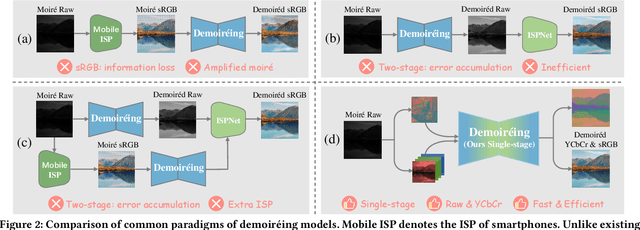
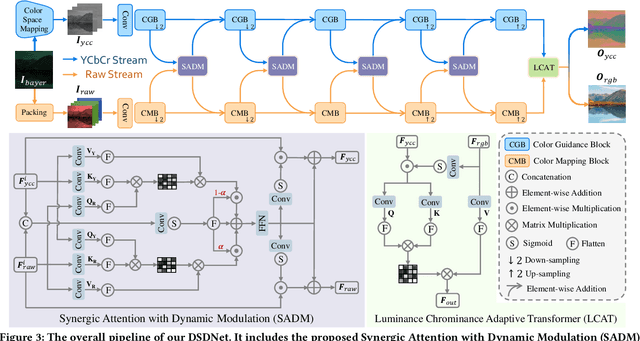
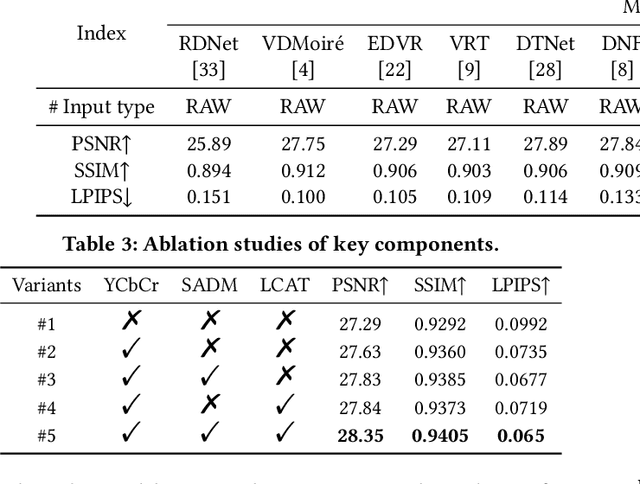
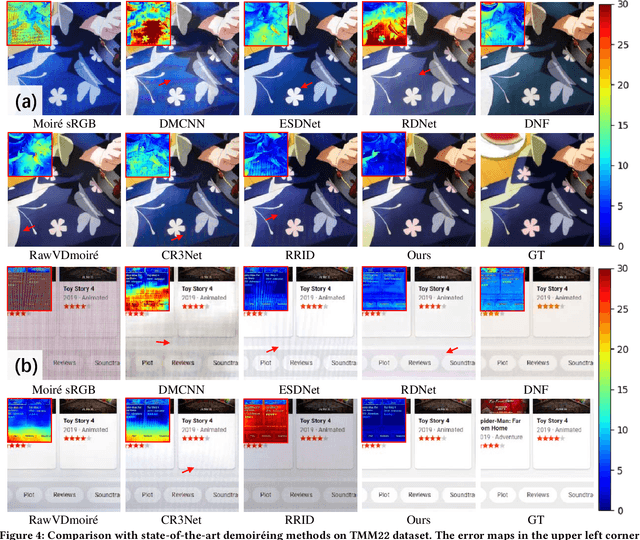
Abstract:With the rapid advancement of mobile imaging, capturing screens using smartphones has become a prevalent practice in distance learning and conference recording. However, moir\'e artifacts, caused by frequency aliasing between display screens and camera sensors, are further amplified by the image signal processing pipeline, leading to severe visual degradation. Existing sRGB domain demoir\'eing methods struggle with irreversible information loss, while recent two-stage raw domain approaches suffer from information bottlenecks and inference inefficiency. To address these limitations, we propose a single-stage raw domain demoir\'eing framework, Dual-Stream Demoir\'eing Network (DSDNet), which leverages the synergy of raw and YCbCr images to remove moir\'e while preserving luminance and color fidelity. Specifically, to guide luminance correction and moir\'e removal, we design a raw-to-YCbCr mapping pipeline and introduce the Synergic Attention with Dynamic Modulation (SADM) module. This module enriches the raw-to-sRGB conversion with cross-domain contextual features. Furthermore, to better guide color fidelity, we develop a Luminance-Chrominance Adaptive Transformer (LCAT), which decouples luminance and chrominance representations. Extensive experiments demonstrate that DSDNet outperforms state-of-the-art methods in both visual quality and quantitative evaluation, and achieves an inference speed $\mathrm{\textbf{2.4x}}$ faster than the second-best method, highlighting its practical advantages. We provide an anonymous online demo at https://xxxxxxxxdsdnet.github.io/DSDNet/.
NTIRE 2025 Challenge on Day and Night Raindrop Removal for Dual-Focused Images: Methods and Results
Apr 19, 2025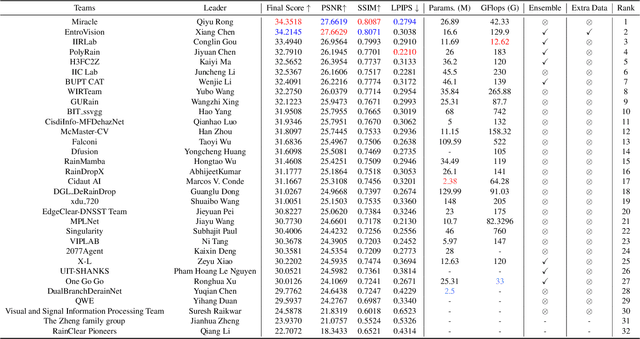
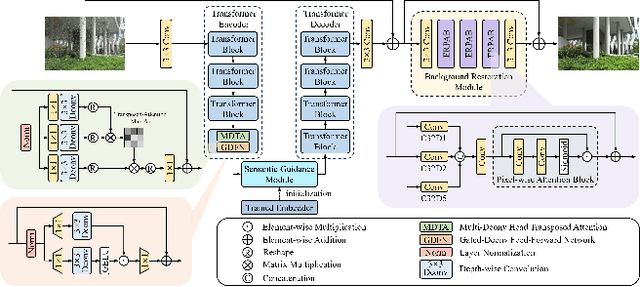
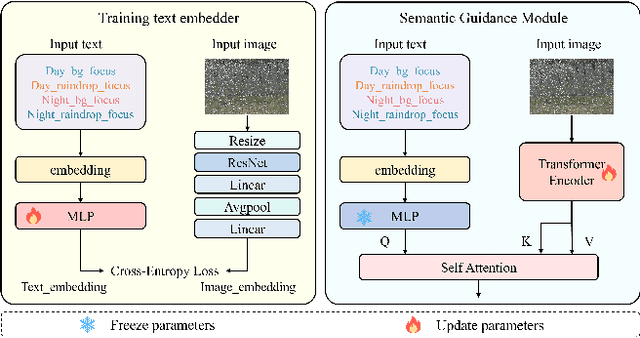
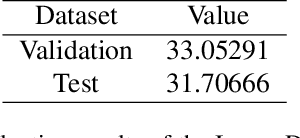
Abstract:This paper reviews the NTIRE 2025 Challenge on Day and Night Raindrop Removal for Dual-Focused Images. This challenge received a wide range of impressive solutions, which are developed and evaluated using our collected real-world Raindrop Clarity dataset. Unlike existing deraining datasets, our Raindrop Clarity dataset is more diverse and challenging in degradation types and contents, which includes day raindrop-focused, day background-focused, night raindrop-focused, and night background-focused degradations. This dataset is divided into three subsets for competition: 14,139 images for training, 240 images for validation, and 731 images for testing. The primary objective of this challenge is to establish a new and powerful benchmark for the task of removing raindrops under varying lighting and focus conditions. There are a total of 361 participants in the competition, and 32 teams submitting valid solutions and fact sheets for the final testing phase. These submissions achieved state-of-the-art (SOTA) performance on the Raindrop Clarity dataset. The project can be found at https://lixinustc.github.io/CVPR-NTIRE2025-RainDrop-Competition.github.io/.
Learning Differential Pyramid Representation for Tone Mapping
Dec 02, 2024



Abstract:Previous tone mapping methods mainly focus on how to enhance tones in low-resolution images and recover details using the high-frequent components extracted from the input image. These methods typically rely on traditional feature pyramids to artificially extract high-frequency components, such as Laplacian and Gaussian pyramids with handcrafted kernels. However, traditional handcrafted features struggle to effectively capture the high-frequency components in HDR images, resulting in excessive smoothing and loss of detail in the output image. To mitigate the above issue, we introduce a learnable Differential Pyramid Representation Network (DPRNet). Based on the learnable differential pyramid, our DPRNet can capture detailed textures and structures, which is crucial for high-quality tone mapping recovery. In addition, to achieve global consistency and local contrast harmonization, we design a global tone perception module and a local tone tuning module that ensure the consistency of global tuning and the accuracy of local tuning, respectively. Extensive experiments demonstrate that our method significantly outperforms state-of-the-art methods, improving PSNR by 2.58 dB in the HDR+ dataset and 3.31 dB in the HDRI Haven dataset respectively compared with the second-best method. Notably, our method exhibits the best generalization ability in the non-homologous image and video tone mapping operation. We provide an anonymous online demo at https://xxxxxx2024.github.io/DPRNet/.
Learning Adaptive Lighting via Channel-Aware Guidance
Dec 02, 2024



Abstract:Learning lighting adaption is a key step in obtaining a good visual perception and supporting downstream vision tasks. There are multiple light-related tasks (e.g., image retouching and exposure correction) and previous studies have mainly investigated these tasks individually. However, we observe that the light-related tasks share fundamental properties: i) different color channels have different light properties, and ii) the channel differences reflected in the time and frequency domains are different. Based on the common light property guidance, we propose a Learning Adaptive Lighting Network (LALNet), a unified framework capable of processing different light-related tasks. Specifically, we introduce the color-separated features that emphasize the light difference of different color channels and combine them with the traditional color-mixed features by Light Guided Attention (LGA). The LGA utilizes color-separated features to guide color-mixed features focusing on channel differences and ensuring visual consistency across channels. We introduce dual domain channel modulation to generate color-separated features and a wavelet followed by a vision state space module to generate color-mixed features. Extensive experiments on four representative light-related tasks demonstrate that LALNet significantly outperforms state-of-the-art methods on benchmark tests and requires fewer computational resources. We provide an anonymous online demo at https://xxxxxx2025.github.io/LALNet/.
Anatomical Consistency Distillation and Inconsistency Synthesis for Brain Tumor Segmentation with Missing Modalities
Aug 25, 2024



Abstract:Multi-modal Magnetic Resonance Imaging (MRI) is imperative for accurate brain tumor segmentation, offering indispensable complementary information. Nonetheless, the absence of modalities poses significant challenges in achieving precise segmentation. Recognizing the shared anatomical structures between mono-modal and multi-modal representations, it is noteworthy that mono-modal images typically exhibit limited features in specific regions and tissues. In response to this, we present Anatomical Consistency Distillation and Inconsistency Synthesis (ACDIS), a novel framework designed to transfer anatomical structures from multi-modal to mono-modal representations and synthesize modality-specific features. ACDIS consists of two main components: Anatomical Consistency Distillation (ACD) and Modality Feature Synthesis Block (MFSB). ACD incorporates the Anatomical Feature Enhancement Block (AFEB), meticulously mining anatomical information. Simultaneously, Anatomical Consistency ConsTraints (ACCT) are employed to facilitate the consistent knowledge transfer, i.e., the richness of information and the similarity in anatomical structure, ensuring precise alignment of structural features across mono-modality and multi-modality. Complementarily, MFSB produces modality-specific features to rectify anatomical inconsistencies, thereby compensating for missing information in the segmented features. Through validation on the BraTS2018 and BraTS2020 datasets, ACDIS substantiates its efficacy in the segmentation of brain tumors with missing MRI modalities.
EMO-LLaMA: Enhancing Facial Emotion Understanding with Instruction Tuning
Aug 21, 2024



Abstract:Facial expression recognition (FER) is an important research topic in emotional artificial intelligence. In recent decades, researchers have made remarkable progress. However, current FER paradigms face challenges in generalization, lack semantic information aligned with natural language, and struggle to process both images and videos within a unified framework, making their application in multimodal emotion understanding and human-computer interaction difficult. Multimodal Large Language Models (MLLMs) have recently achieved success, offering advantages in addressing these issues and potentially overcoming the limitations of current FER paradigms. However, directly applying pre-trained MLLMs to FER still faces several challenges. Our zero-shot evaluations of existing open-source MLLMs on FER indicate a significant performance gap compared to GPT-4V and current supervised state-of-the-art (SOTA) methods. In this paper, we aim to enhance MLLMs' capabilities in understanding facial expressions. We first generate instruction data for five FER datasets with Gemini. We then propose a novel MLLM, named EMO-LLaMA, which incorporates facial priors from a pretrained facial analysis network to enhance human facial information. Specifically, we design a Face Info Mining module to extract both global and local facial information. Additionally, we utilize a handcrafted prompt to introduce age-gender-race attributes, considering the emotional differences across different human groups. Extensive experiments show that EMO-LLaMA achieves SOTA-comparable or competitive results across both static and dynamic FER datasets. The instruction dataset and code are available at https://github.com/xxtars/EMO-LLaMA.
From Recognition to Prediction: Leveraging Sequence Reasoning for Action Anticipation
Aug 05, 2024



Abstract:The action anticipation task refers to predicting what action will happen based on observed videos, which requires the model to have a strong ability to summarize the present and then reason about the future. Experience and common sense suggest that there is a significant correlation between different actions, which provides valuable prior knowledge for the action anticipation task. However, previous methods have not effectively modeled this underlying statistical relationship. To address this issue, we propose a novel end-to-end video modeling architecture that utilizes attention mechanisms, named Anticipation via Recognition and Reasoning (ARR). ARR decomposes the action anticipation task into action recognition and sequence reasoning tasks, and effectively learns the statistical relationship between actions by next action prediction (NAP). In comparison to existing temporal aggregation strategies, ARR is able to extract more effective features from observable videos to make more reasonable predictions. In addition, to address the challenge of relationship modeling that requires extensive training data, we propose an innovative approach for the unsupervised pre-training of the decoder, which leverages the inherent temporal dynamics of video to enhance the reasoning capabilities of the network. Extensive experiments on the Epic-kitchen-100, EGTEA Gaze+, and 50salads datasets demonstrate the efficacy of the proposed methods. The code is available at https://github.com/linuxsino/ARR.
Adversarial Robustness in RGB-Skeleton Action Recognition: Leveraging Attention Modality Reweighter
Jul 29, 2024



Abstract:Deep neural networks (DNNs) have been applied in many computer vision tasks and achieved state-of-the-art (SOTA) performance. However, misclassification will occur when DNNs predict adversarial examples which are created by adding human-imperceptible adversarial noise to natural examples. This limits the application of DNN in security-critical fields. In order to enhance the robustness of models, previous research has primarily focused on the unimodal domain, such as image recognition and video understanding. Although multi-modal learning has achieved advanced performance in various tasks, such as action recognition, research on the robustness of RGB-skeleton action recognition models is scarce. In this paper, we systematically investigate how to improve the robustness of RGB-skeleton action recognition models. We initially conducted empirical analysis on the robustness of different modalities and observed that the skeleton modality is more robust than the RGB modality. Motivated by this observation, we propose the \formatword{A}ttention-based \formatword{M}odality \formatword{R}eweighter (\formatword{AMR}), which utilizes an attention layer to re-weight the two modalities, enabling the model to learn more robust features. Our AMR is plug-and-play, allowing easy integration with multimodal models. To demonstrate the effectiveness of AMR, we conducted extensive experiments on various datasets. For example, compared to the SOTA methods, AMR exhibits a 43.77\% improvement against PGD20 attacks on the NTU-RGB+D 60 dataset. Furthermore, it effectively balances the differences in robustness between different modalities.
 Add to Chrome
Add to Chrome Add to Firefox
Add to Firefox Add to Edge
Add to Edge